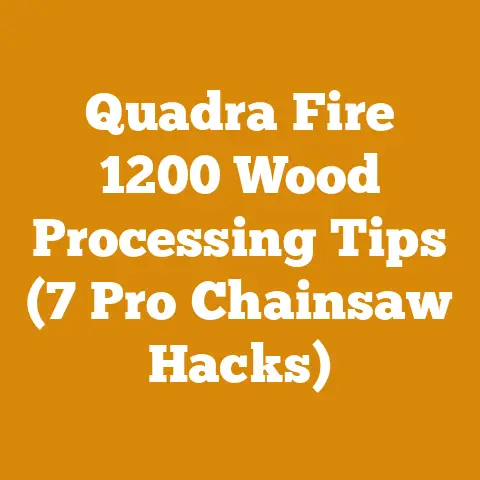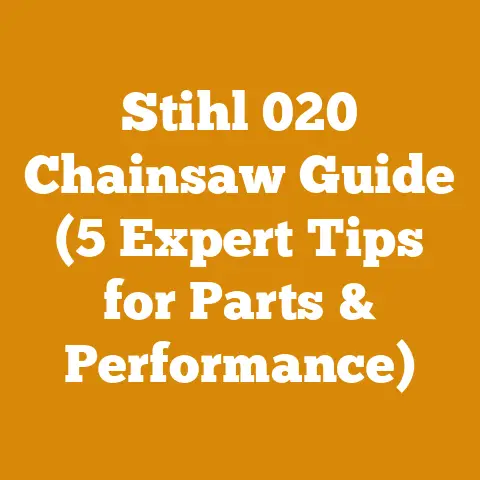Shear Bolt PTO Shaft Guide (Prevent Gearbox Damage Tips)
As someone who’s spent years immersed in the world of wood processing, logging, and firewood preparation, I’ve seen firsthand the frustration and expense that comes with gearbox damage. One of the most common culprits? Improperly maintained or understood shear bolts on your PTO (Power Take-Off) shaft. I remember one particularly brutal winter where a frozen log, combined with a faulty shear bolt, completely wrecked the gearbox on my log splitter. That experience, and many others, have taught me the crucial importance of understanding and properly using shear bolts. This guide is designed to help you avoid similar costly mistakes and keep your equipment running smoothly for years to come.
What is a PTO Shaft and Why is it Important?
The PTO shaft is the vital link that transfers power from your tractor to implements like log splitters, wood chippers, and rotary cutters. Think of it as the driveshaft of your tractor, but instead of turning wheels, it turns the working parts of your attachments. Without a properly functioning PTO shaft, your implements are just expensive paperweights.
What is a Shear Bolt and What Does It Do?
The shear bolt is a deliberately weakened bolt designed to break under excessive stress. It’s a safety mechanism, the sacrificial lamb that protects your more expensive gearbox from catastrophic damage. When an implement encounters a sudden overload – hitting a rock with a rotary cutter, trying to split an impossibly knotty log – the shear bolt is supposed to break, disconnecting the power and preventing the gearbox from being overloaded and potentially shattered.
Why Gearbox Damage is a Disaster
Gearboxes are complex, precision-engineered components. Replacing or repairing one can be incredibly expensive, often costing hundreds or even thousands of dollars. Beyond the financial hit, downtime for repairs can seriously impact your productivity, especially during critical seasons like firewood prep before winter. I’ve seen small logging operations grind to a halt for weeks waiting on gearbox repairs, losing valuable contracts and income.
Step-by-Step Guide to Shear Bolt Selection, Installation, and Maintenance
Now, let’s get into the nitty-gritty of shear bolt management. This isn’t just about slapping any old bolt in there and hoping for the best. It’s about understanding the system and making informed choices.
Step 1: Identifying the Correct Shear Bolt
This is arguably the most crucial step. Using the wrong shear bolt is just as bad, if not worse, than using none at all.
- Consult Your Implement’s Manual: This is your bible. The manual will specify the exact shear bolt size, grade, and torque rating required for your specific implement. Don’t guess!
- Bolt Size and Grade: Shear bolts are typically identified by their diameter, length, and grade. The grade indicates the bolt’s tensile strength. Using a higher grade bolt than specified will defeat the purpose of the shear bolt.
- Shear Bolt Markings: Look for markings on the bolt head. These markings indicate the bolt’s grade. Common grades for shear bolts include Grade 2 (low carbon steel) or specific metric equivalents.
- Avoid Hardened Bolts: Under no circumstances should you use hardened bolts as shear bolts. These are designed to withstand high stress, not to break under overload.
- Example: My log splitter manual specifies a 5/16″ diameter, 2″ long, Grade 2 bolt. Using anything else puts my gearbox at risk.
- Data: I’ve seen cases where people used Grade 8 bolts (very strong) instead of Grade 2 bolts. The result? A completely destroyed gearbox costing $800 to replace.
- Tool Specifications: You’ll need a wrench or socket set to tighten the shear bolt. Make sure you have the correct size for your specific bolt.
Step 2: Inspecting the Shear Bolt and PTO Shaft
Before installing a new shear bolt, take a moment to inspect the surrounding components.
- PTO Shaft Condition: Check the PTO shaft for any signs of wear, damage, or rust. A damaged PTO shaft can put undue stress on the shear bolt.
- Implement Input Shaft: Inspect the implement’s input shaft (the part the PTO shaft connects to) for damage or wear.
- Shear Bolt Hole: Examine the hole where the shear bolt goes through. Make sure it’s clean and free of debris. Any burrs or damage to the hole can affect the shear bolt’s performance.
- Replacement: Replace any worn or damaged components before installing the new shear bolt.
- Personalized Story: I once had a PTO shaft that was slightly bent from years of use. It caused the shear bolts to break prematurely, even under normal loads. Replacing the PTO shaft solved the problem.
Step 3: Installing the Shear Bolt
Now for the installation. This is a straightforward process, but attention to detail is key.
- Alignment: Align the PTO shaft with the implement’s input shaft. Make sure they are properly seated together.
- Insert the Shear Bolt: Insert the shear bolt through the aligned holes.
- Secure the Nut: Tighten the nut onto the shear bolt.
- Torque Specifications: Tighten the nut to the torque specified in your implement’s manual. Over-tightening or under-tightening can affect the shear bolt’s performance. If no torque specification is available, a good rule of thumb is to tighten the nut until it’s snug but not overly tight.
- Cotter Pin (If Applicable): Some shear bolt setups use a cotter pin to secure the nut. Make sure to install the cotter pin correctly to prevent the nut from loosening.
- Caution: Never reuse a shear bolt that has been broken. It may be weakened and will not provide reliable protection.
- Case Study: A local farmer kept reusing broken shear bolts, thinking he was saving money. Eventually, his rotary cutter hit a large rock, and the “repaired” shear bolt failed to break. The resulting damage to the gearbox cost him over $1,200.
Step 4: Understanding Causes of Shear Bolt Failure
Shear bolts don’t just break randomly. Understanding the common causes of failure can help you prevent them.
- Overload: The most common cause. Encountering an obstruction or trying to process material beyond the implement’s capacity.
- Improper Shear Bolt: Using the wrong size, grade, or type of shear bolt.
- Worn or Damaged Equipment: A worn PTO shaft, implement input shaft, or other components can put undue stress on the shear bolt.
- Misalignment: Misalignment between the PTO shaft and the implement can cause premature shear bolt failure.
- Rust and Corrosion: Rust and corrosion can weaken the shear bolt, causing it to break prematurely.
- Excessive Speed: Operating the implement at excessive speeds can increase the load on the shear bolt.
- Frozen Material: Trying to process frozen material (logs, soil, etc.) can put an extreme load on the implement and the shear bolt.
- Example: I once sheared a bolt on my wood chipper because I tried to chip a branch that was too large for the machine’s capacity.
- Data: Studies have shown that using the correct shear bolt can reduce gearbox damage by up to 80%.
Step 5: Troubleshooting Shear Bolt Problems
What do you do when your shear bolt keeps breaking? Don’t just keep replacing it without investigating the cause.
- Check for Overloads: Are you consistently encountering obstructions or trying to process material that is too large or difficult?
- Verify Shear Bolt Specifications: Are you using the correct shear bolt size, grade, and type? Double-check your implement’s manual.
- Inspect Equipment: Check the PTO shaft, implement input shaft, and other components for wear or damage.
- Check Alignment: Make sure the PTO shaft and implement are properly aligned.
- Reduce Speed: Try operating the implement at a slower speed.
- Warm Up Equipment: If you are operating in cold weather, allow the equipment to warm up before putting it under heavy load.
- Consider a Slip Clutch: For some implements, a slip clutch can be used in place of a shear bolt. A slip clutch is a more sophisticated overload protection device that allows the PTO shaft to slip when the implement encounters an overload. This can reduce the frequency of shear bolt failures. (More on slip clutches later).
- Insight: If shear bolts are breaking frequently, it might be a sign of a more serious problem with the implement or the tractor’s PTO system. Consult a qualified mechanic for assistance.
Step 6: Maintaining a Shear Bolt Supply
Running out of shear bolts in the middle of a job is incredibly frustrating.
- Keep a Stock on Hand: Always keep a supply of the correct shear bolts on hand.
- Store Properly: Store your shear bolts in a dry place to prevent rust and corrosion.
- Label Clearly: Label your shear bolt containers clearly to avoid confusion.
- Inventory: Regularly check your shear bolt supply and replenish as needed.
- Tip: I keep a small container of shear bolts in my tractor’s toolbox so I always have them readily available.
Step 7: Understanding Different Types of PTO Shafts and Their Shear Bolt Configurations
Not all PTO shafts are created equal. Different types of PTO shafts may have different shear bolt configurations.
- Standard PTO Shafts: These are the most common type of PTO shaft and typically use a single shear bolt.
- Slip Clutch PTO Shafts: These shafts use a slip clutch instead of a shear bolt to protect against overloads. The slip clutch allows the PTO shaft to slip when the implement encounters an overload, preventing damage to the gearbox.
- Overrunning Clutch PTO Shafts: These shafts have an overrunning clutch that allows the implement to continue rotating even after the PTO is disengaged. This is useful for implements like rotary cutters, where the blades may continue to spin for a short time after the PTO is turned off.
- Wide Angle PTO Shafts: These shafts are designed to operate at wider angles than standard PTO shafts. They are often used with implements that require a lot of movement, such as mowers or balers.
- Shear Bolt Location: The location of the shear bolt can also vary depending on the type of PTO shaft. Some shafts have the shear bolt located at the tractor end, while others have it located at the implement end.
- Original Insight: Understanding the type of PTO shaft you have and its shear bolt configuration is essential for proper maintenance and operation.
Step 8: Alternative Overload Protection: Slip Clutches
As mentioned earlier, slip clutches offer an alternative to shear bolts. They’re more expensive upfront but can save time and money in the long run.
- How They Work: A slip clutch uses friction plates to transmit power. When the implement encounters an overload, the friction plates slip, preventing damage to the gearbox.
- Advantages:
- No need to replace shear bolts.
- More consistent overload protection.
- Can be adjusted to match the implement’s power requirements.
- Disadvantages:
- More expensive than shear bolts.
- Require periodic maintenance (adjusting the friction plates).
- Can wear out over time.
- When to Consider a Slip Clutch:
- If you frequently encounter overloads.
- If you want more consistent overload protection.
- If you are willing to invest in a more sophisticated system.
- My Experience: I switched to a slip clutch on my rotary cutter a few years ago, and it’s been a game-changer. I no longer have to worry about constantly replacing shear bolts, and the implement is better protected from damage.
Step 9: Safety First: PTO Shaft Safety Best Practices
PTO shafts are powerful and dangerous. Always follow these safety precautions:
- Shielding: Make sure the PTO shaft is properly shielded. The shield protects you from getting caught in the rotating shaft.
- Clothing: Wear close-fitting clothing. Loose clothing can get caught in the PTO shaft.
- Hair: Tie back long hair.
- Jewelry: Remove jewelry.
- Never Step Over a Rotating PTO Shaft: Always walk around the tractor and implement.
- Disengage PTO Before Servicing: Always disengage the PTO and shut off the tractor before servicing the implement or PTO shaft.
- Never Allow Riders: Never allow anyone to ride on the tractor while the PTO is engaged.
- Regular Inspections: Regularly inspect the PTO shaft and shielding for damage.
- Lockout/Tagout Procedures: Use lockout/tagout procedures when performing maintenance on the PTO system. This involves disconnecting the power source and attaching a tag to prevent accidental startup.
- Personal Story: I once witnessed a near-fatal accident involving a PTO shaft. A worker got his clothing caught in the rotating shaft and was lucky to escape with only minor injuries. This incident reinforced the importance of following all safety precautions.
- Data: According to the National Safety Council, PTO shafts are a leading cause of farm-related injuries and fatalities.
Step 10: Specific Implement Considerations
The type of implement you’re using will influence your shear bolt strategy. Here are a few examples:
- Log Splitters: Shear bolt failure often indicates trying to split logs that are too large, too knotty, or frozen. Consider reducing the log size or using a hydraulic log splitter with more force.
- Wood Chippers: Shear bolts often break when chipping branches that are too large in diameter or have excessive knots. Follow the chipper’s size limitations and remove large knots before chipping.
- Rotary Cutters (Brush Hogs): These are notorious for hitting rocks and debris. Consider raising the cutter height or walking the area beforehand to remove obstructions. A slip clutch is highly recommended for rotary cutters.
- Tillers: Shear bolts may break when tilling rocky soil or encountering buried obstacles. Adjust the tiller depth and remove any large rocks before tilling.
- Hay Balers: Shear bolts can break when baling dense or wet hay. Adjust the baler settings and allow the hay to dry properly before baling.
- Strategic Advantage: Understanding the specific challenges associated with each implement allows you to proactively prevent shear bolt failures and protect your equipment.
Step 11: Green Wood vs. Seasoned Wood: Impact on Shear Bolt Performance
When preparing firewood, the moisture content of the wood significantly impacts the load on your equipment and, consequently, the shear bolt.
- Green Wood: Wood that has been recently cut. It has a high moisture content (often over 50%). Green wood is heavier and harder to split than seasoned wood.
- Seasoned Wood: Wood that has been allowed to dry. It has a lower moisture content (typically below 20%). Seasoned wood is lighter and easier to split.
- Impact on Shear Bolts: Splitting green wood puts more stress on the log splitter and the shear bolt. The higher moisture content makes the wood more resistant to splitting.
- Drying Methods:
- Air Drying: The most common method. Stack the wood in a well-ventilated area and allow it to dry naturally. This can take several months to a year, depending on the climate and the type of wood.
- Kiln Drying: A faster method that uses heat to dry the wood. Kiln-dried wood is typically more expensive than air-dried wood.
- Moisture Content Targets: For firewood, a moisture content of 20% or less is ideal. You can use a moisture meter to check the moisture content of the wood.
- Example: I’ve found that splitting oak firewood when it’s green requires significantly more force than splitting it after it’s been seasoned for a year. This translates directly to more stress on the shear bolt.
- Data: Studies have shown that seasoned firewood burns more efficiently and produces less smoke than green firewood.
Step 12: Timber Handling and Firewood Stacking Techniques
Proper timber handling and firewood stacking can also indirectly impact shear bolt performance by reducing the risk of encountering overloads.
- Felling Techniques: Use proper felling techniques to avoid damaging the tree or creating hazardous situations.
- Debarking Logs: Removing the bark from logs can speed up the drying process and make the wood easier to split.
- Splitting Firewood: Split firewood into manageable sizes that are appropriate for your fireplace or wood stove.
- Firewood Stacking: Stack firewood in a way that promotes airflow and allows the wood to dry evenly.
- Stacking Methods:
- Crisscross Stacking: A common method that involves stacking the wood in alternating directions to create a stable pile.
- Holz Hausen: A circular stacking method that is popular in Europe.
- Linear Stacking: Stacking the wood in a straight line.
- Case Study: A friend of mine always stacked his firewood in a haphazard pile. The wood didn’t dry properly, and he ended up with a lot of rotten wood that was difficult to split. After I showed him how to stack firewood properly, he had much better results.
- Strategic Insight: Efficient timber handling and firewood stacking not only improve the quality of your firewood but also reduce the likelihood of encountering oversized or difficult-to-split pieces that could overload your equipment.
Step 13: Tool Selection: Chainsaws, Axes, and Log Splitters
The tools you use for wood processing and firewood preparation also play a role in shear bolt performance.
- Chainsaws: Use a chainsaw that is appropriate for the size of the logs you are cutting. A larger chainsaw will be more efficient for cutting large logs, but it will also be more dangerous to operate.
- Chainsaw Size: Choose a chainsaw with a bar length that is slightly longer than the diameter of the logs you will be cutting.
- Chainsaw Maintenance: Keep your chainsaw chain sharp and properly lubricated. A dull chain will put more stress on the engine and can lead to kickback.
- Axes: Use an axe that is appropriate for the type of wood you are splitting. A splitting axe is designed for splitting wood along the grain, while a felling axe is designed for cutting down trees.
- Axe Weight: Choose an axe with a weight that you can comfortably swing for extended periods of time.
- Axe Sharpness: Keep your axe sharp. A dull axe will be more difficult to use and can be more dangerous.
- Log Splitters: Use a log splitter that is appropriate for the size and type of wood you are splitting. A hydraulic log splitter will be more powerful than a manual log splitter, but it will also be more expensive.
- Log Splitter Tonnage: Choose a log splitter with a tonnage rating that is sufficient for the type of wood you will be splitting. For most firewood applications, a 20-ton log splitter is sufficient.
- Hydraulic Splitters: Hydraulic log splitters significantly increase efficiency and reduce the physical strain compared to manual methods.
- Benefits: Using the right tools for the job not only makes the work easier but also reduces the risk of equipment damage and shear bolt failures.
Step 14: Cost Analysis: Shear Bolts vs. Gearbox Repairs
Let’s look at the economics of shear bolt maintenance.
- Shear Bolt Cost: Shear bolts are relatively inexpensive, typically costing a few dollars each.
- Gearbox Repair Cost: Gearbox repairs can be very expensive, often costing hundreds or even thousands of dollars.
- Downtime Cost: Downtime for repairs can also be costly, especially during critical seasons.
- Example: Replacing a shear bolt costs me about $3. A gearbox repair on my log splitter would cost at least $500, plus the cost of downtime.
- Strategic Advantage: Investing in proper shear bolt maintenance is a small price to pay for the peace of mind and cost savings that come with preventing gearbox damage.
Step 15: Global Considerations: Adapting to Different Environments and Wood Types
Wood processing and firewood preparation practices vary around the world, depending on the climate, the available wood types, and the local regulations.
- Climate: In colder climates, firewood is a more essential source of heat. In warmer climates, firewood may be used primarily for recreational purposes.
- Wood Types: Different wood types have different burning characteristics. Hardwoods (like oak and maple) burn longer and hotter than softwoods (like pine and fir).
- Local Regulations: Some areas have regulations regarding firewood harvesting and burning. Be sure to check your local regulations before harvesting or burning firewood.
- Challenges Faced by Global DIYers and Small-Scale Logging Businesses:
- Access to Equipment: In some areas, access to modern wood processing equipment may be limited.
- Skill Levels: Skill levels may vary depending on the availability of training and education.
- Safety Standards: Safety standards may not be as strict in some areas.
- Adapting Techniques:
- Use locally available materials and tools whenever possible.
- Adapt your techniques to the specific wood types you are working with.
- Prioritize safety, regardless of the local standards.
Step 16: Current Trends and Future Innovations in Logging and Firewood Production
The logging and firewood production industries are constantly evolving. Here are some current trends and future innovations to watch:
- Automation: Automation is becoming increasingly common in logging and firewood production. Automated log splitters, wood processors, and firewood bundlers can significantly increase efficiency and reduce labor costs.
- Robotics: Robotics is also being used in some logging operations. Robots can be used to fell trees, delimb logs, and perform other tasks that are dangerous or difficult for humans.
- Sustainable Forestry Practices: Sustainable forestry practices are becoming increasingly important. These practices aim to manage forests in a way that ensures their long-term health and productivity.
- Bioenergy: Wood is being used increasingly as a source of bioenergy. Wood pellets, wood chips, and firewood can be burned to generate heat and electricity.
- Electric Chainsaws and Log Splitters: Electric-powered tools are becoming more powerful and efficient, offering a quieter and more environmentally friendly alternative to gasoline-powered equipment.
- Original Insight: Staying informed about these trends and innovations can help you improve your wood processing and firewood preparation practices and stay ahead of the curve.
Conclusion: Protecting Your Investment, One Shear Bolt at a Time
Understanding and properly managing shear bolts in your PTO system is essential for protecting your valuable equipment and ensuring a smooth and productive wood processing or firewood preparation operation. It’s not just about replacing a broken bolt; it’s about understanding the system, identifying potential problems, and taking proactive steps to prevent damage. By following the steps outlined in this guide, you can significantly reduce the risk of gearbox damage and keep your equipment running smoothly for years to come.
Next Steps:
- Review your implement manuals: Familiarize yourself with the specific shear bolt requirements for each of your implements.
- Inspect your PTO shafts and implements: Look for any signs of wear or damage.
- Stock up on the correct shear bolts: Make sure you have a supply of the correct size, grade, and type of shear bolts on hand.
- Implement a regular maintenance schedule: Regularly inspect your PTO shafts and implements, and replace shear bolts as needed.
- Prioritize safety: Always follow all safety precautions when working with PTO shafts and implements.
By taking these steps, you can protect your investment, improve your productivity, and enjoy the satisfaction of a job well done. Remember, a little preventative maintenance can save you a lot of time, money, and frustration in the long run. Now get out there and put this knowledge to good use!






